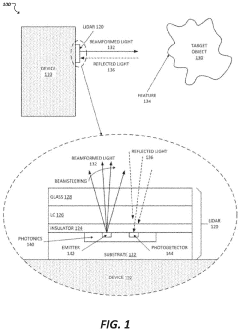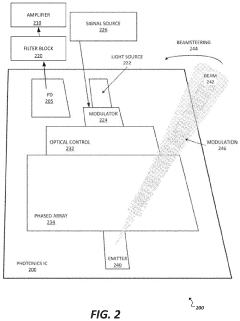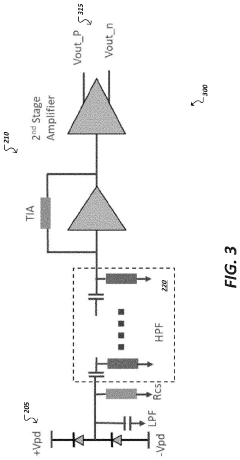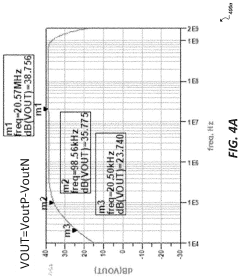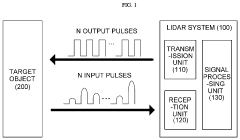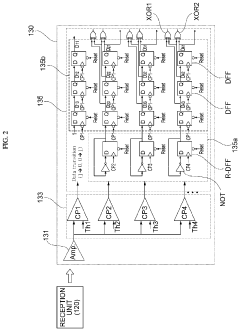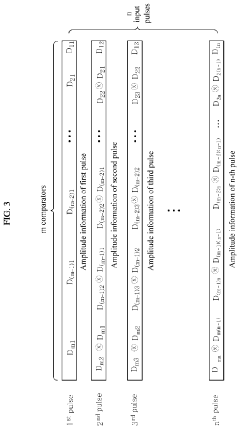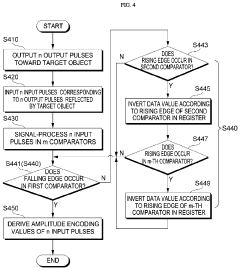Role of High Pass Filters in Signal Conditioning for Lidar Systems
JUL 28, 20259 MIN READ
Generate Your Research Report Instantly with AI Agent
Patsnap Eureka helps you evaluate technical feasibility & market potential.
Lidar Signal Conditioning Background and Objectives
Lidar technology has evolved significantly over the past few decades, revolutionizing various industries with its ability to provide accurate 3D mapping and object detection. The development of lidar systems has been driven by the increasing demand for autonomous vehicles, robotics, and advanced surveying applications. As the technology progresses, the focus has shifted towards improving the accuracy, range, and reliability of lidar systems.
Signal conditioning plays a crucial role in enhancing the performance of lidar systems by optimizing the raw sensor data for further processing. Within this context, high pass filters have emerged as a critical component in the signal conditioning chain. These filters are designed to attenuate low-frequency noise and DC offset, allowing the system to focus on the high-frequency components that contain valuable information about the reflected laser pulses.
The primary objective of implementing high pass filters in lidar signal conditioning is to improve the signal-to-noise ratio (SNR) and overall system sensitivity. By removing unwanted low-frequency components, these filters help to isolate the rapid changes in the received signal that correspond to laser reflections from objects in the environment. This enhancement in signal quality leads to more accurate distance measurements and better object detection capabilities.
Another key goal is to address the challenges posed by ambient light interference and sensor drift. High pass filters can effectively suppress the slowly varying background illumination and compensate for gradual changes in sensor characteristics, ensuring consistent performance across different environmental conditions. This is particularly important for lidar systems operating in dynamic outdoor environments where lighting conditions can change rapidly.
As lidar technology continues to advance, there is a growing emphasis on miniaturization and power efficiency. In this context, the development of compact and energy-efficient high pass filter designs has become a priority. Researchers and engineers are exploring novel filter architectures and materials to achieve optimal performance while minimizing size and power consumption.
The integration of high pass filters with other signal conditioning elements, such as amplifiers and analog-to-digital converters, is another area of focus. The goal is to create a seamless and efficient signal processing pipeline that maximizes the information extracted from the raw lidar sensor data. This holistic approach to signal conditioning is essential for pushing the boundaries of lidar system performance and enabling new applications across various industries.
Signal conditioning plays a crucial role in enhancing the performance of lidar systems by optimizing the raw sensor data for further processing. Within this context, high pass filters have emerged as a critical component in the signal conditioning chain. These filters are designed to attenuate low-frequency noise and DC offset, allowing the system to focus on the high-frequency components that contain valuable information about the reflected laser pulses.
The primary objective of implementing high pass filters in lidar signal conditioning is to improve the signal-to-noise ratio (SNR) and overall system sensitivity. By removing unwanted low-frequency components, these filters help to isolate the rapid changes in the received signal that correspond to laser reflections from objects in the environment. This enhancement in signal quality leads to more accurate distance measurements and better object detection capabilities.
Another key goal is to address the challenges posed by ambient light interference and sensor drift. High pass filters can effectively suppress the slowly varying background illumination and compensate for gradual changes in sensor characteristics, ensuring consistent performance across different environmental conditions. This is particularly important for lidar systems operating in dynamic outdoor environments where lighting conditions can change rapidly.
As lidar technology continues to advance, there is a growing emphasis on miniaturization and power efficiency. In this context, the development of compact and energy-efficient high pass filter designs has become a priority. Researchers and engineers are exploring novel filter architectures and materials to achieve optimal performance while minimizing size and power consumption.
The integration of high pass filters with other signal conditioning elements, such as amplifiers and analog-to-digital converters, is another area of focus. The goal is to create a seamless and efficient signal processing pipeline that maximizes the information extracted from the raw lidar sensor data. This holistic approach to signal conditioning is essential for pushing the boundaries of lidar system performance and enabling new applications across various industries.
Market Analysis for Lidar Systems
The Lidar (Light Detection and Ranging) systems market has been experiencing significant growth in recent years, driven by the increasing demand for autonomous vehicles, advanced driver-assistance systems (ADAS), and various industrial applications. The global Lidar market size was valued at approximately $1.8 billion in 2021 and is projected to reach $5.7 billion by 2026, growing at a CAGR of 25.8% during the forecast period.
The automotive sector remains the primary driver of Lidar market growth, with major automakers and technology companies investing heavily in autonomous vehicle development. The adoption of Lidar technology in ADAS applications is also contributing to market expansion, as car manufacturers seek to enhance safety features and improve overall driving experience.
Beyond automotive applications, Lidar systems are finding increasing use in sectors such as robotics, smart cities, forestry, and agriculture. The demand for high-resolution 3D mapping and surveying capabilities has led to the adoption of Lidar technology in urban planning, infrastructure development, and environmental monitoring.
The market for Lidar systems is characterized by intense competition and rapid technological advancements. Key players in the industry are focusing on developing more compact, cost-effective, and high-performance Lidar solutions to meet the evolving needs of various applications. Solid-state Lidar technology, in particular, is gaining traction due to its potential for mass production and lower costs compared to traditional mechanical Lidar systems.
Geographically, North America currently dominates the Lidar market, followed by Europe and Asia-Pacific. The United States, in particular, has been at the forefront of Lidar technology development and adoption, driven by its strong automotive and technology sectors. However, the Asia-Pacific region is expected to witness the highest growth rate in the coming years, fueled by increasing investments in autonomous vehicles and smart city initiatives in countries like China, Japan, and South Korea.
The role of high-pass filters in signal conditioning for Lidar systems is crucial for improving the overall performance and accuracy of these devices. As the demand for more precise and reliable Lidar systems grows across various industries, the market for advanced signal conditioning components, including high-pass filters, is expected to expand in tandem with the broader Lidar market.
In conclusion, the Lidar systems market is poised for substantial growth in the coming years, driven by technological advancements, increasing adoption across multiple industries, and the push towards autonomous vehicles and smart infrastructure. The continued development of signal conditioning technologies, including high-pass filters, will play a vital role in shaping the future of Lidar systems and their applications.
The automotive sector remains the primary driver of Lidar market growth, with major automakers and technology companies investing heavily in autonomous vehicle development. The adoption of Lidar technology in ADAS applications is also contributing to market expansion, as car manufacturers seek to enhance safety features and improve overall driving experience.
Beyond automotive applications, Lidar systems are finding increasing use in sectors such as robotics, smart cities, forestry, and agriculture. The demand for high-resolution 3D mapping and surveying capabilities has led to the adoption of Lidar technology in urban planning, infrastructure development, and environmental monitoring.
The market for Lidar systems is characterized by intense competition and rapid technological advancements. Key players in the industry are focusing on developing more compact, cost-effective, and high-performance Lidar solutions to meet the evolving needs of various applications. Solid-state Lidar technology, in particular, is gaining traction due to its potential for mass production and lower costs compared to traditional mechanical Lidar systems.
Geographically, North America currently dominates the Lidar market, followed by Europe and Asia-Pacific. The United States, in particular, has been at the forefront of Lidar technology development and adoption, driven by its strong automotive and technology sectors. However, the Asia-Pacific region is expected to witness the highest growth rate in the coming years, fueled by increasing investments in autonomous vehicles and smart city initiatives in countries like China, Japan, and South Korea.
The role of high-pass filters in signal conditioning for Lidar systems is crucial for improving the overall performance and accuracy of these devices. As the demand for more precise and reliable Lidar systems grows across various industries, the market for advanced signal conditioning components, including high-pass filters, is expected to expand in tandem with the broader Lidar market.
In conclusion, the Lidar systems market is poised for substantial growth in the coming years, driven by technological advancements, increasing adoption across multiple industries, and the push towards autonomous vehicles and smart infrastructure. The continued development of signal conditioning technologies, including high-pass filters, will play a vital role in shaping the future of Lidar systems and their applications.
High Pass Filters in Lidar: Current State and Challenges
High pass filters play a crucial role in signal conditioning for LiDAR systems, addressing several key challenges in the current state of LiDAR technology. These filters are essential for enhancing the quality and accuracy of LiDAR measurements by effectively removing low-frequency noise and unwanted background signals.
One of the primary challenges in LiDAR systems is the presence of ambient light and background radiation, which can interfere with the detection of reflected laser pulses. High pass filters help mitigate this issue by attenuating low-frequency components of the received signal, allowing the system to focus on the high-frequency content that typically contains the desired LiDAR information.
Another significant challenge is the need for improved signal-to-noise ratio (SNR) in LiDAR systems. High pass filters contribute to SNR enhancement by suppressing low-frequency noise sources, such as thermal noise and electronic interference. This filtering action enables LiDAR systems to detect weaker return signals and achieve greater range and resolution.
The current state of high pass filters in LiDAR systems involves both analog and digital implementations. Analog high pass filters are often used in the front-end circuitry of LiDAR receivers, providing initial signal conditioning before analog-to-digital conversion. Digital high pass filters, implemented in software or digital signal processors, offer greater flexibility and precision in tailoring the filter response to specific LiDAR applications.
Despite their benefits, high pass filters in LiDAR systems face several challenges. One such challenge is the trade-off between filter performance and system bandwidth. Aggressive high pass filtering can improve noise rejection but may also attenuate useful low-frequency components of the LiDAR signal, potentially reducing the system's ability to detect slowly varying features in the environment.
Another challenge lies in the design of high pass filters for wideband LiDAR systems. As LiDAR technology advances towards higher bandwidths to improve resolution and data acquisition rates, the design of high pass filters must evolve to maintain optimal performance across broader frequency ranges.
The integration of high pass filters with other signal processing techniques, such as automatic gain control and adaptive thresholding, presents both opportunities and challenges. While these combined approaches can significantly enhance LiDAR performance, they also increase system complexity and computational requirements.
One of the primary challenges in LiDAR systems is the presence of ambient light and background radiation, which can interfere with the detection of reflected laser pulses. High pass filters help mitigate this issue by attenuating low-frequency components of the received signal, allowing the system to focus on the high-frequency content that typically contains the desired LiDAR information.
Another significant challenge is the need for improved signal-to-noise ratio (SNR) in LiDAR systems. High pass filters contribute to SNR enhancement by suppressing low-frequency noise sources, such as thermal noise and electronic interference. This filtering action enables LiDAR systems to detect weaker return signals and achieve greater range and resolution.
The current state of high pass filters in LiDAR systems involves both analog and digital implementations. Analog high pass filters are often used in the front-end circuitry of LiDAR receivers, providing initial signal conditioning before analog-to-digital conversion. Digital high pass filters, implemented in software or digital signal processors, offer greater flexibility and precision in tailoring the filter response to specific LiDAR applications.
Despite their benefits, high pass filters in LiDAR systems face several challenges. One such challenge is the trade-off between filter performance and system bandwidth. Aggressive high pass filtering can improve noise rejection but may also attenuate useful low-frequency components of the LiDAR signal, potentially reducing the system's ability to detect slowly varying features in the environment.
Another challenge lies in the design of high pass filters for wideband LiDAR systems. As LiDAR technology advances towards higher bandwidths to improve resolution and data acquisition rates, the design of high pass filters must evolve to maintain optimal performance across broader frequency ranges.
The integration of high pass filters with other signal processing techniques, such as automatic gain control and adaptive thresholding, presents both opportunities and challenges. While these combined approaches can significantly enhance LiDAR performance, they also increase system complexity and computational requirements.
Existing High Pass Filter Solutions for Lidar
01 High-pass filter design for signal conditioning
High-pass filters are used in signal conditioning to attenuate low-frequency components while allowing high-frequency signals to pass through. These filters can be implemented using various circuit configurations, including RC networks, active filters with operational amplifiers, or digital filter designs. The cutoff frequency and filter order can be adjusted to meet specific application requirements.- High-pass filter design for signal conditioning: High-pass filters are used in signal conditioning to attenuate low-frequency components while allowing high-frequency signals to pass through. These filters can be implemented using various circuit configurations, including RC networks, active filters with operational amplifiers, or digital filter designs. The cutoff frequency and filter order are key parameters in designing high-pass filters for specific applications.
- High-pass filtering in communication systems: High-pass filters play a crucial role in communication systems for signal conditioning and noise reduction. They are used to remove DC offsets, low-frequency interference, and unwanted baseline wander in transmitted signals. These filters can be implemented in both analog and digital domains, improving signal quality and enhancing the overall performance of communication systems.
- High-pass filtering in image and video processing: In image and video processing applications, high-pass filters are employed for edge detection, sharpening, and noise reduction. These filters can enhance high-frequency details in images and videos, improving overall visual quality. Various implementations, including spatial domain filters and frequency domain techniques, are used to achieve desired filtering effects in image and video processing systems.
- Adaptive high-pass filtering techniques: Adaptive high-pass filtering techniques involve dynamically adjusting filter parameters based on input signal characteristics or system requirements. These methods can optimize filter performance in real-time, adapting to changing signal conditions or environmental factors. Adaptive high-pass filters find applications in various fields, including audio processing, biomedical signal analysis, and communication systems.
- Integration of high-pass filters in mixed-signal systems: High-pass filters are often integrated into mixed-signal systems, combining analog and digital processing techniques. These filters can be implemented as part of analog front-end circuits, analog-to-digital converters, or digital signal processing stages. The integration of high-pass filters in mixed-signal systems enables efficient signal conditioning and improves overall system performance in various applications, such as sensor interfaces and data acquisition systems.
02 Signal conditioning for analog-to-digital conversion
High-pass filters are employed in signal conditioning circuits to prepare analog signals for analog-to-digital conversion. These filters help remove DC offset and low-frequency noise, improving the accuracy of the digitized signal. The filtered signal can then be amplified and scaled appropriately before being fed into an analog-to-digital converter.Expand Specific Solutions03 Adaptive high-pass filtering techniques
Adaptive high-pass filtering techniques are used to dynamically adjust filter characteristics based on input signal properties or system requirements. These methods can involve real-time parameter estimation, automatic gain control, or digital signal processing algorithms to optimize filter performance for varying signal conditions.Expand Specific Solutions04 High-pass filtering in image and video processing
High-pass filters are utilized in image and video processing applications to enhance edge detection, remove low-frequency background noise, and improve overall image quality. These filters can be implemented in both hardware and software, and are often combined with other image processing techniques to achieve desired results.Expand Specific Solutions05 Integration of high-pass filters in communication systems
High-pass filters are integrated into various communication systems to improve signal quality and reduce interference. These filters are used in transmitters and receivers to remove unwanted low-frequency components, suppress harmonics, and enhance the overall performance of the communication link. They can be implemented using discrete components, integrated circuits, or as part of a larger signal processing system.Expand Specific Solutions
Key Players in Lidar Signal Processing Industry
The role of high pass filters in signal conditioning for LiDAR systems is a critical area of technological development, currently in a growth phase. The market for LiDAR systems is expanding rapidly, driven by applications in autonomous vehicles, robotics, and industrial automation. Key players like Robert Bosch GmbH, Hesai Technology, and Ouster Technologies are investing heavily in R&D to improve LiDAR performance. The technology's maturity is advancing, with companies such as Infineon Technologies and ams-Osram International developing specialized components. However, challenges remain in signal processing and noise reduction, areas where high pass filters play a crucial role. As the industry progresses, we can expect further innovations in filter design and integration to enhance LiDAR system capabilities.
Hesai Technology Co. Ltd.
Technical Solution: Hesai has developed advanced signal conditioning techniques for their LiDAR systems, incorporating high-pass filters to enhance signal quality. Their approach involves using active high-pass filters with carefully tuned cutoff frequencies to effectively remove low-frequency noise and DC offset from the received LiDAR signals[1]. This technique allows for improved detection of small, fast-moving objects and better performance in challenging environmental conditions. Hesai's implementation also includes adaptive filter parameters that adjust based on the operating environment, optimizing performance across various scenarios[2]. The company has integrated these high-pass filters into their signal processing pipeline, which includes amplification, digitization, and advanced signal processing algorithms, resulting in enhanced range accuracy and reduced false detections[3].
Strengths: Improved detection of small, fast-moving objects; better performance in challenging environments; adaptive filtering for various scenarios. Weaknesses: Potential loss of some low-frequency information; increased complexity in signal processing chain.
Ouster Technologies, Inc.
Technical Solution: Ouster has implemented a sophisticated high-pass filtering system in their LiDAR signal conditioning process. Their approach utilizes digital high-pass filters implemented on FPGAs, allowing for real-time adjustment of filter characteristics[4]. The company's technology employs a cascaded filter design, combining multiple high-pass stages to achieve sharp cutoff characteristics while maintaining low latency. Ouster's filters are designed to effectively remove ambient light interference and low-frequency noise, particularly important for their digital flash LiDAR technology[5]. The filter parameters are dynamically adjusted based on the sensor's operating mode and environmental conditions, optimizing performance for different use cases such as automotive, industrial, and robotics applications[6]. Additionally, Ouster has developed proprietary algorithms that work in conjunction with the high-pass filters to further enhance signal quality and reduce false positives.
Strengths: Real-time adjustable filter characteristics; effective removal of ambient light interference; optimized for various applications. Weaknesses: Potential for increased power consumption due to FPGA implementation; complexity in filter parameter optimization.
Core Innovations in High Pass Filter Design for Lidar
On-chip back reflection filtering
PatentPendingUS20220221566A1
Innovation
- The integration of a solid-state Lidar engine on a single chip using semiconductor photonics with phase control mechanisms like liquid crystal on silicon (LCOS) or thermo-optic and electro-optic phase arrays, eliminating mechanical parts and incorporating high-pass filter circuitry to mitigate noise from optical back reflections.
LIDAR system and signal processing method thereof
PatentActiveUS11885914B2
Innovation
- A LIDAR system and signal processing method utilizing a comparator circuit and encoding algorithm to convert continuous signal pulses into discrete signals using variable reference voltages, eliminating the need for ADCs and separate clock sources, thereby simplifying the circuitry and reducing power consumption.
Regulatory Standards for Lidar Systems
Regulatory standards for LiDAR systems play a crucial role in ensuring the safety, reliability, and performance of these advanced sensing technologies. As LiDAR becomes increasingly prevalent in autonomous vehicles, robotics, and various industrial applications, governments and regulatory bodies worldwide have established comprehensive guidelines to govern their development and deployment.
In the United States, the National Highway Traffic Safety Administration (NHTSA) has taken a leading role in developing regulatory frameworks for LiDAR systems in automotive applications. The NHTSA's Federal Motor Vehicle Safety Standards (FMVSS) include specific requirements for LiDAR sensors used in advanced driver assistance systems (ADAS) and autonomous vehicles. These standards address aspects such as sensor performance, durability, and electromagnetic compatibility.
The European Union has also implemented stringent regulations for LiDAR systems through the European New Car Assessment Programme (Euro NCAP). The Euro NCAP protocols outline performance criteria for LiDAR sensors used in vehicle safety systems, including object detection capabilities, range accuracy, and environmental resilience.
In addition to automotive applications, regulatory standards for LiDAR systems extend to other sectors. The International Electrotechnical Commission (IEC) has developed standards for LiDAR systems used in industrial and environmental monitoring applications. These standards focus on aspects such as measurement accuracy, data quality, and system calibration.
The aviation industry has its own set of regulatory requirements for LiDAR systems. The Federal Aviation Administration (FAA) in the United States and the European Union Aviation Safety Agency (EASA) have established guidelines for the use of LiDAR in aircraft navigation, obstacle detection, and terrain mapping. These regulations address issues such as sensor performance, integration with existing avionics systems, and cybersecurity measures.
As LiDAR technology continues to evolve, regulatory bodies are adapting their standards to address emerging challenges. For instance, the increasing use of solid-state LiDAR systems has prompted the development of new testing protocols to evaluate their performance and reliability. Additionally, regulatory efforts are focusing on standardizing data formats and communication protocols to ensure interoperability between different LiDAR systems and other sensing technologies.
Compliance with these regulatory standards is essential for manufacturers and developers of LiDAR systems. It not only ensures the safety and reliability of their products but also facilitates market acceptance and integration into various applications. As the technology advances, ongoing collaboration between industry stakeholders and regulatory bodies will be crucial in refining and updating these standards to keep pace with innovation while maintaining public safety and trust in LiDAR-based systems.
In the United States, the National Highway Traffic Safety Administration (NHTSA) has taken a leading role in developing regulatory frameworks for LiDAR systems in automotive applications. The NHTSA's Federal Motor Vehicle Safety Standards (FMVSS) include specific requirements for LiDAR sensors used in advanced driver assistance systems (ADAS) and autonomous vehicles. These standards address aspects such as sensor performance, durability, and electromagnetic compatibility.
The European Union has also implemented stringent regulations for LiDAR systems through the European New Car Assessment Programme (Euro NCAP). The Euro NCAP protocols outline performance criteria for LiDAR sensors used in vehicle safety systems, including object detection capabilities, range accuracy, and environmental resilience.
In addition to automotive applications, regulatory standards for LiDAR systems extend to other sectors. The International Electrotechnical Commission (IEC) has developed standards for LiDAR systems used in industrial and environmental monitoring applications. These standards focus on aspects such as measurement accuracy, data quality, and system calibration.
The aviation industry has its own set of regulatory requirements for LiDAR systems. The Federal Aviation Administration (FAA) in the United States and the European Union Aviation Safety Agency (EASA) have established guidelines for the use of LiDAR in aircraft navigation, obstacle detection, and terrain mapping. These regulations address issues such as sensor performance, integration with existing avionics systems, and cybersecurity measures.
As LiDAR technology continues to evolve, regulatory bodies are adapting their standards to address emerging challenges. For instance, the increasing use of solid-state LiDAR systems has prompted the development of new testing protocols to evaluate their performance and reliability. Additionally, regulatory efforts are focusing on standardizing data formats and communication protocols to ensure interoperability between different LiDAR systems and other sensing technologies.
Compliance with these regulatory standards is essential for manufacturers and developers of LiDAR systems. It not only ensures the safety and reliability of their products but also facilitates market acceptance and integration into various applications. As the technology advances, ongoing collaboration between industry stakeholders and regulatory bodies will be crucial in refining and updating these standards to keep pace with innovation while maintaining public safety and trust in LiDAR-based systems.
Environmental Impact of Lidar Technology
The environmental impact of LiDAR technology is a crucial consideration as its applications continue to expand across various industries. LiDAR systems, while offering significant benefits in terms of accuracy and efficiency, also have potential environmental implications that warrant careful examination.
One of the primary environmental concerns associated with LiDAR technology is its energy consumption. LiDAR systems, particularly those used in autonomous vehicles and large-scale mapping projects, require substantial power to operate effectively. This increased energy demand can contribute to higher carbon emissions if the power source is not renewable, potentially exacerbating climate change issues.
However, it is important to note that LiDAR technology also offers several environmental benefits. In forestry and land management, LiDAR enables more accurate monitoring of forest health, biomass estimation, and carbon sequestration potential. This data can inform better conservation strategies and support efforts to mitigate climate change. Similarly, in urban planning, LiDAR-based 3D mapping can optimize building designs for energy efficiency and help create more sustainable cities.
The use of LiDAR in precision agriculture presents another environmental consideration. While it can lead to more efficient use of resources such as water and fertilizers, reducing overall environmental impact, the technology itself may have implications for local ecosystems. The frequent use of aerial LiDAR surveys, for instance, could potentially disturb wildlife habitats or migration patterns.
In the context of autonomous vehicles, LiDAR technology plays a crucial role in improving safety and efficiency. By enabling more precise navigation and obstacle detection, LiDAR-equipped vehicles can potentially reduce traffic congestion and accidents, leading to lower fuel consumption and emissions. However, the widespread adoption of LiDAR in vehicles also raises questions about the long-term environmental impact of manufacturing and disposing of these sophisticated sensors.
The marine application of LiDAR technology, particularly in bathymetric surveys, presents both opportunities and challenges from an environmental perspective. While it allows for more accurate mapping of coastal areas and marine habitats, potentially aiding in conservation efforts, the use of high-powered lasers in aquatic environments may have unforeseen effects on marine life that require further study.
As LiDAR technology continues to evolve, efforts are being made to address its environmental footprint. Research is ongoing to develop more energy-efficient LiDAR systems, explore the use of sustainable materials in sensor production, and optimize data processing algorithms to reduce computational power requirements. These advancements aim to mitigate the technology's environmental impact while maximizing its benefits across various applications.
One of the primary environmental concerns associated with LiDAR technology is its energy consumption. LiDAR systems, particularly those used in autonomous vehicles and large-scale mapping projects, require substantial power to operate effectively. This increased energy demand can contribute to higher carbon emissions if the power source is not renewable, potentially exacerbating climate change issues.
However, it is important to note that LiDAR technology also offers several environmental benefits. In forestry and land management, LiDAR enables more accurate monitoring of forest health, biomass estimation, and carbon sequestration potential. This data can inform better conservation strategies and support efforts to mitigate climate change. Similarly, in urban planning, LiDAR-based 3D mapping can optimize building designs for energy efficiency and help create more sustainable cities.
The use of LiDAR in precision agriculture presents another environmental consideration. While it can lead to more efficient use of resources such as water and fertilizers, reducing overall environmental impact, the technology itself may have implications for local ecosystems. The frequent use of aerial LiDAR surveys, for instance, could potentially disturb wildlife habitats or migration patterns.
In the context of autonomous vehicles, LiDAR technology plays a crucial role in improving safety and efficiency. By enabling more precise navigation and obstacle detection, LiDAR-equipped vehicles can potentially reduce traffic congestion and accidents, leading to lower fuel consumption and emissions. However, the widespread adoption of LiDAR in vehicles also raises questions about the long-term environmental impact of manufacturing and disposing of these sophisticated sensors.
The marine application of LiDAR technology, particularly in bathymetric surveys, presents both opportunities and challenges from an environmental perspective. While it allows for more accurate mapping of coastal areas and marine habitats, potentially aiding in conservation efforts, the use of high-powered lasers in aquatic environments may have unforeseen effects on marine life that require further study.
As LiDAR technology continues to evolve, efforts are being made to address its environmental footprint. Research is ongoing to develop more energy-efficient LiDAR systems, explore the use of sustainable materials in sensor production, and optimize data processing algorithms to reduce computational power requirements. These advancements aim to mitigate the technology's environmental impact while maximizing its benefits across various applications.
Unlock deeper insights with Patsnap Eureka Quick Research — get a full tech report to explore trends and direct your research. Try now!
Generate Your Research Report Instantly with AI Agent
Supercharge your innovation with Patsnap Eureka AI Agent Platform!
